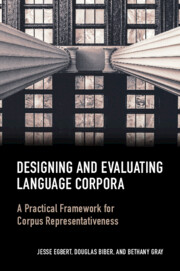Book contents
- Designing and Evaluating Language Corpora
- Designing and Evaluating Language Corpora
- Copyright page
- Contents
- Figures
- Tables
- Acknowledgments
- 1 Introduction
- 2 Approaches to Representativeness in Previous Corpus Linguistic Research
- 3 Corpus Representativeness
- 4 Domain Considerations
- 5 Distribution Considerations
- 6 The Influence of Domain and Distribution Considerations on Corpus Representativeness
- 7 Corpus Design and Representativeness in Practice – With Daniel Keller
- Glossary
- Book part
- References
- Index
7 - Corpus Design and Representativeness in Practice – With Daniel Keller
Published online by Cambridge University Press: 07 April 2022
- Designing and Evaluating Language Corpora
- Designing and Evaluating Language Corpora
- Copyright page
- Contents
- Figures
- Tables
- Acknowledgments
- 1 Introduction
- 2 Approaches to Representativeness in Previous Corpus Linguistic Research
- 3 Corpus Representativeness
- 4 Domain Considerations
- 5 Distribution Considerations
- 6 The Influence of Domain and Distribution Considerations on Corpus Representativeness
- 7 Corpus Design and Representativeness in Practice – With Daniel Keller
- Glossary
- Book part
- References
- Index
Summary
We propose that the representativeness of a corpus directly depends on its suitability for a specific research goal (including the domain and the linguistic feature(s) of interest). Creating a new corpus involves establishing linguistic research question(s), addressing domain considerations, including describing the domain, operationalizing the domain, evaluating the operational domain (relative to the full domain), designing the corpus, and evaluating the corpus (relative to the operational domain), addressing distribution considerations, including defining a linguistic variable and evaluating the required sample size, collecting the corpus, and documenting and reporting corpus design and representativeness. The steps for evaluating an existing corpus are similar: establishing linguistic research question(s), identifying and acquire the corpus and its documentation, addressing domain considerations, including describing the domain and evaluating the operational domain relative to the full domain, and the corpus relative to the operational domain, addressing distribution considerations, including defining a linguistic variable and evaluating the required sample size, and documenting and reporting corpus design and representativeness. We conclude the book by arguing that corpus representativeness is important for both corpus designers/builders, and corpus researchers who need to evaluate whether a corpus is appropriate for their research goals.
Keywords
- Type
- Chapter
- Information
- Designing and Evaluating Language CorporaA Practical Framework for Corpus Representativeness, pp. 177 - 219Publisher: Cambridge University PressPrint publication year: 2022



